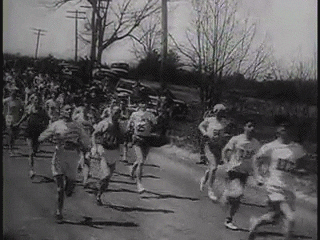Each step with dystonia can feel like a marathon. As it turns out, some people in the community mean that literally.

Marathons—the 26.2 mile behemoths—have become a worldwide phenomenon. The TCS New York City Marathon alone had over 50,000 finishers and raised more than $30 million for charity in 2014.
Groups and individuals representing movement disorders have been a huge part of that for years.
As a literal representation of the struggle for steps, teams of caregivers, doctors, friends, and family join those with dystonia in races across the globe.
One notable team of 10 added to the 2015 TCS NYC Marathon total by raising an incredible $40,000 for the Dystonia Medical Research Foundation.

Source: www.giphy.com
That team entered into the long history of dedicated dystonia runners, including these five amazing marathoners:
At 21 years old, Kevin Enners wanted to compete in the ultimate adrenaline outlet: the Boston Marathon. Many would say a young man diagnosed with cerebral palsy at birth and dystonia later in life can’t move toward that goal. But “can’t” doesn’t exist in Kevin’s vocabulary. Strapped into a modified bike, he and his dad worked together to finish their qualifying race in Albany. Unfortunately, due to his dad’s back injury, the Enners men didn’t make the time to qualify for Boston, but they finished the Albany Marathon with smiles, tears and family by their side.
Emily Goldstein loves to run, but she didn’t look much like a “runner” as a kid, with her turned foot and uncontrolled hands. Eventually diagnosed with dystonia, Emily was wheelchair-bound by age 12. To get relief for their daughter, the Goldstein’s agreed to brain surgery and two years later, Emily saw astonishing and unexpected results. Now out of the wheelchair, Emily trained for the Los Angeles Marathon in 2013 to raise awareness for everyone still in one.
The record for the most times one person ran the Boston Marathon? 61, an achievement held by Olympian Johnny Kelley. It’s a number Ben Beach hopes to surpass and he’s not far off. Ben ran his first Boston Marathon in 1968 and hasn’t stopped since: not for rain, heat, or for a diagnosis of dystonia. While his symptoms—located mostly in his left hamstring—mean Ben doesn’t have the prettiest gait or the best finishing times, he refuses to quit. He just finished his 48th Boston Marathon earlier in 2015, and Ben has every plan of continuing his race toward the record.
Carrie Siu Butt is a community inspiration. She struggled with painful walking experiences with dystonia, but her symptoms underwent a drastic change with deep brain stimulation. Carrie was able to not only walk—she could run. She completed two half marathons in honor of her sister, herself, and others with dystonia. Though she retired from marathons, she still continues to run and update her blog (appropriately called Run Carrie Run!) as a source of support for others.
Michael J. Fox has become one of movement disorders’ most recognizable faces and Team Fox creates some of the most recognizable fundraising racing teams in the country. With a racing roster that includes celebrities like Ryan Reynolds, as well as thousands of dedicated people like Eva Matthews (who developed dystonia after a charging bird struck her in the head) Team Fox connects interested runners to the cause. However, Michael J. Fox isn’t just a name. As the Central Jersey Dystonia Support and Action Group can testify, (with picture proof) Michael J. Fox may not be running with the team, but like many people with dystonia, he’s cheering on those who can.
They estimate that a marathon takes about 50,000 steps to complete, but really, each of us only needs to move one step forward to be a marathon ahead of where we were before.


